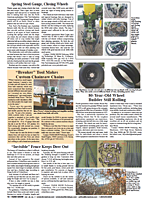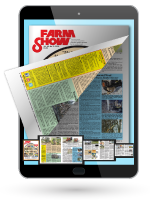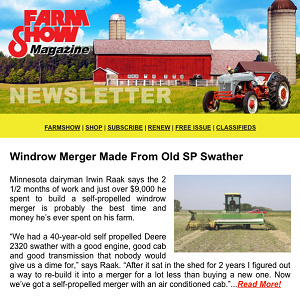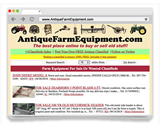You have reached your limit of 3 free stories. A story preview is shown instead.
To view more stories
To view more stories
SUBSCRIBE OR RENEW NOW
(If your subscription is current, click here to Login or Register.)2025 - Volume #49, Issue #4, Page #2
[ Sample Stories From This Issue | List of All Stories In This Issue]
Car Company Launched A 4-WD UTV In 1950
In today’s age of UTV performance, tech, comfort and high cost, it’s difficult to comprehend that in 1950, an all-purpose UTV with 4-WD cost just $795.A tiny 26.5-hp cast iron overhead cam engine powered the Crosley Farm-O-Road model FOR-1. Shifting was through a Warner 3-speed T-92 transmission. It weighed jus..........

You must sign in, subscribe or renew to see the page.

You must sign in, subscribe or renew to see the flip-book
Car Company Launched A 4-WD UTV In 1950
In today’s age of UTV performance, tech, comfort and high cost, it’s difficult to comprehend that in 1950, an all-purpose UTV with 4-WD cost just $795.
A tiny 26.5-hp cast iron overhead cam engine powered the Crosley Farm-O-Road model FOR-1. Shifting was through a Warner 3-speed T-92 transmission. It weighed just 1,100 lbs., had a 63-in. wheelbase, and a small cargo box. The FOR-2 model, which added a hydraulic drawbar and optional front or rear PTO, sold for $939.
Both models were all-purpose utility vehicles that could pull trailers or wagons, mow grass and pull a small plow, harrow, cultivator, hay rake or seeder. FOR-2, with its hydraulic drawbar and PTO options, could easily operate a mounted sickle bar mower, a post hole digger or spring blocks.
The FORs didn’t actually have 4-WD as we know it today. Power went only to the rear axle. However, owners mounted 5.00-12 Goodyear Sure Grip agricultural duals on the rear wheels and called their rigs 4-WD. It was a practical idea for tough conditions and made for good conversation.
Farm-O-Road vehicles were the product of inventive genius Powel Crosley Jr. and the Crosley Motor Company. Although now a footnote in automotive and manufacturing history, Crosley was a true entrepreneur and skilled inventor in the early 1900s.
He’d made a fortune in the early 1920s by inventing and selling thousands of home radios for about $20. A few years later, he invented the Shelvador, a high-quality, low-cost refrigerator with patented shelving. That venture led him into gas and electric ranges, washers and electric ironers. Funds from those inventions gained him entrance into farming, broadcasting and major league baseball as owner of the Cincinnati Reds in 1934. For years, the team played in Crosley Field, named after him.
Even with all his success, one of his biggest dreams was to build an economical vehicle. He tried in 1917 and failed. Nearly 20 years later, with profits made in other businesses, he built a working prototype of a small car. More than 300 of his appliance dealers signed up to sell it.
The car had an 80-in. wheelbase, almost 15 in. shorter than a VW Beetle. It weighed just 925 lbs., was powered by a 12-hp Waukesha air-cooled twin-cylinder engine and sold for just $250. About 2,000 units were sold in its debut year.
Variations of the original were added in 1940 and 1941. One was the Woody Wagon, with a small cargo box. Others included Parkway and Panel delivery vehicles, a station wagon and a Convertible Coupe. With the U.S. entry into WWII, Crosley turned its auto plants to producing proximity fuses for wartime use. They would detonate an antiaircraft shell close enough to an enemy plane to destroy it.
After the war, Crosley was slow to return to automobile production. Its 1947 model cars had a new 44-cu. in. displacement COBRA engine that weighed just 133 lbs. and produced 26 hp. The engine had been used to power refrigeration units and portable generators during the war, but engineers warned that it had design flaws for use in a car. The company produced 19,000 units in 1947 and 29,000 units in 1948, regardless. Engine problems began surfacing in 1949, and by 1950, buyers had many other choices from the “Big 3” automakers.
In the spring of 1952, with clouds building over his auto business, Crosley sold out to General Tire, which quit producing autos at his plants and retrofitted them for tire production. Crosley cars were soon relegated to low-cost auto resellers, and many were just abandoned.
Those that did survive were scooped up by hobbyists, who grew into a tightly knit owners’ group known today as the Crosley Collectors Club. More than 800 CCC members worldwide still keep their tiny cars in top condition. They show them at local events and to other owners at the national Crosley show. The 2025 event is July 7-12 at the Fulton County Fairgrounds in Wauseon, Ohio. Attendees can register in one of 15 different stock, non-stock and additional show classes, including those for best Crosley picture, best non-automotive product, most original car and highly modified Rat Rods. Other awards are given for the longest distance driven or trailered, as well as a Hard Luck award.
Show director Jim Ballman says the event typically draws 400 or more entries, and the show goes on rain or shine.
“It’s always tremendous fun and camaraderie for Crosley owners, who share a special bond.”
Contact: FARM SHOW Followup, Crosley Auto Club, 22450 Skunk River Rd., Danville, Iowa 52623 (www.crosleyautoclub.com).
To read the rest of this story, download this issue below or click here to register with your account number.



